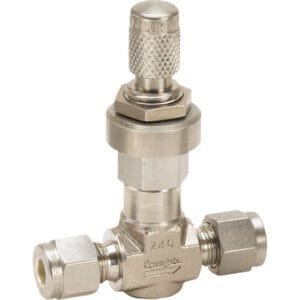KF (QF) HV Blank Flanges (Brass): Economical Sealing for General High-Vacuum Applications
KF (QF) HV Blank Flanges (Brass) are essential components used to cap or seal off unused KF ports in high-vacuum (HV) systems. These flanges are engineered for vacuum isolation in foreline plumbing, chamber ports, and instrumentation setups, providing a secure, leak-tight seal that ensures the stability and integrity of the vacuum system. Designed according to KF (QF) international standards, these blanks are interchangeable with all standard KF hardware.
Crafted from high-quality brass, KF (QF) HV Blank Flanges (Brass) offer a balance of performance, durability, and cost-effectiveness. While not as corrosion-resistant as stainless steel, brass is ideal for general-purpose vacuum applications where chemical exposure and extreme temperature conditions are not primary concerns. These blank flanges are commonly found in laboratory setups, vacuum coating systems, analytical instruments, and OEM equipment where unused ports must be reliably sealed.
Each KF (QF) HV Blank Flange (Brass) features a flat, non-bored sealing face with a chamfered back surface. When mated with another KF flange using a centering ring and elastomeric o-ring, and secured by a circumferential clamp (such as wing-nut, thumbscrew, or bolt-style), the flange creates a vacuum-tight seal rated for pressures down to 10⁻⁸ Torr. The seal integrity depends on the o-ring material, which also defines the operational temperature range—typically 0 °C to 120–180 °C.
One of the main advantages of KF (QF) HV Blank Flanges (Brass) is their modularity and reusability. Unlike welded or custom-sealed terminations, these blanks can be quickly installed, removed, or relocated as system needs evolve—making them particularly suitable for flexible research environments and systems in development or prototyping stages.
TFM supplies KF (QF) HV Blank Flanges (Brass) in all standard KF sizes including KF16, KF25, KF40, and KF50. These components are manufactured to tight tolerances for consistent, leak-free performance and full compatibility with other KF system components. For specific needs such as vent holes or customized flange geometry, custom machining options are available upon request.
In summary, KF (QF) HV Blank Flanges (Brass) provide a reliable, cost-efficient solution for sealing unused KF ports in general-purpose high-vacuum systems. Their simple installation, KF-standard compatibility, and dependable vacuum sealing performance make them an indispensable tool for vacuum engineers and technicians across research, industry, and OEM environments.
Ordering Table
Accessories Table
| Description | For | Per Package | Part Number |
| Cast Clamps (Aluminum) | KF10, KF16 Flanges | 1 | QF16-075-C |
| Cast Clamps (Aluminum) | KF25 Flanges | 1 | QF25-100-C |
| Cast Clamps (Aluminum) | KF40 Flanges | 1 | QF40-150-C |
| Cast Clamps (Aluminum) | KF50 Flanges | 1 | QF50-200-C |
| Lever Clamps (Aluminum) | KF10, KF16 Flanges | 1 | QF16-075-CHA |
| Lever Clamps (Aluminum) | KF25 Flanges | 1 | QF25-100-CHA |
| Lever Clamps (Aluminum) | KF40 Flanges | 1 | QF40-150-CHA |
| Description | For | Per Package | Part Number |





Reviews
There are no reviews yet.